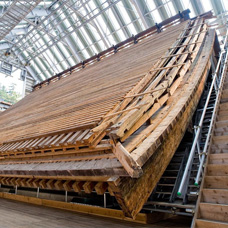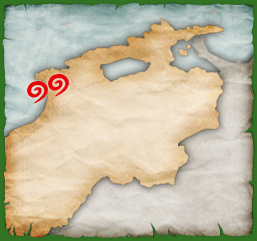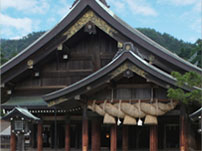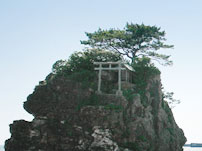Sengu
- What is Sengu?
- Architectural Details
- Process
- Ise Connection
Architectural Details
Written by Dustin Kidd
The current main hall of Izumo Taisha, having been built in 1744, is almost 270 years old, and as mentioned before, its 24-meter height makes it the tallest shrine building in the country. The roof of the shrine, which is made of bark (hiwada) from Japanese cypress trees (hinoki), is totally exposed to the elements, and after 60 years, the wind, rain, snow, and sun take their toll on the roof. Birds also pull out pieces of bark to make their nests in the roof, and large patches of moss grow near the eaves. 60 years is considered to be the general limit for a cypress bark roof to last, so after that time has passed, the entire roof is replaced. This is no small task. With a thickness of almost one meter, and a total area of 590 m2, it takes over 640,000 strips of cypress bark, weighing nearly 47 tons, to roof the entire shrine. Although other shrines and temples throughout the country are also roofed with hiwada, they only use strips that are 75 cm in length, and while Izumo Taisha also uses strips of that length, it is the only place in the entire country to use longer strips as well. These extra-length strips of hiwada are either 105cm or 120 cm long, and it is the combination of the three lengths of bark that gives the main hall of Izumo Taisha its unique, impressive curve.
All of these strips of hiwada are held in place by bamboo nails, as regular nails would soon rust and damage the bark. These nails are only made in one location in the entire country, but for this sengu, 800 kilograms (1760 pounds) worth of bamboo nails were produced. Why so many? Due to its thickness, about 9000 nails are used per each square meter of roof.
The thickness of the roof is deliberate, as it has been designed to prevent any rain from leaking through. What is really impressive, however, is how carefully put together the supporting foundation underneath the roofing is. Izumo Taisha’s roof foundation consists of three thick layers that are also designed to prevent any leaking or water damage should any water actually make it through the hiwada. The boards that run downwards from the top of the main hall are slightly carved in the middle to create a path for water to flow down, and then outside, the roof. Also, a traditional sealant called kokuso, made from a mixture of lacquer, small fibers, and wood dust, is used to fill in any spaces between these boards.

A view of the roof structure of Izumo Taisha's main hall after the cypress bark roofing has been removed.
- Dustin Kidd, Japanese Cultural Scholar
- Author of “Oi Genki Ka!?”, a collection of essays about life in Japan and “San-in English School”, a daily column about different facets of life in the San-in Region of Japan, which ran from Oct. 2009 to Mar 2011.
Lecturer: “Comparing Japanese and Greek Mythology”, “Experiences with Shinto”, “The Appeal of Shinto and Buddhism.”
Visiting Locations connected to Izumo Taisha
Izumo Taisha is located on the western end of the Shimane Peninsula, in the Taisha area of Izumo City. A large shrine gate, said to be the largest in Japan, towers over the main road to Izumo Taisha and welcomes visitors to the area. Izumo Taisha is easily accessible by car, bus, or train, and the area around the shrine bustles with tourists and visitors to the shrine, especially on the weekends.
If you follow the road that passes in front of the shrine grounds, you will soon arrive at Inasa-no-Hama beach. This beach is part of Sono-no-nagahama, a place that plays a large role in the Kunibiki legend, and is where Takemikazuchi presented Okuninushi with his demands to turn over Ashihara-no-nakatsukuni to Amaterasu, and where Takeminakata challenged him to a test of strength. It is also where, every year at the Kami-mukae-sai, all of the gods from around Japan are welcomed to Izumo Taisha, and the procession back to Izumo Taisha from the beach follows a path through town along the Kami Mukae Road.


Izumo Taisha
195 Kizukihigashi, Taisha-cho, Izumo City, Shimane

Inasa-no-Hama
Kizukikita, Taisha-cho, Izumo City, Shimane













